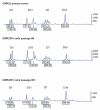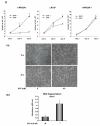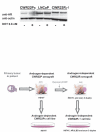Androgen-regulated and highly tumorigenic human prostate cancer cell line established from a transplantable primary CWR22 tumor
- PMID: 18829484
- PMCID: PMC2570751
- DOI: 10.1158/1078-0432.CCR-08-0979
Androgen-regulated and highly tumorigenic human prostate cancer cell line established from a transplantable primary CWR22 tumor
Abstract
Purpose: One of the major obstacles in understanding the molecular mechanisms underlying the transition of prostate cancer growth from androgen dependency to a hormone-refractory state is the lack of androgen-regulated and tumorigenic human prostate cancer cell lines.
Experimental design: We have established and characterized a new human prostate cancer cell line, CWR22Pc, derived from the primary CWR22 human prostate xenograft tumors.
Results: The growth of CWR22Pc cells is induced markedly by dihydrotestosterone, and CWR22Pc cells express high levels of androgen receptor (AR) and prostate-specific antigen (PSA). Importantly, PSA expression in CWR22Pc cells is regulated by androgens. Stat5a/b, Stat3, Akt, and mitogen-activated protein kinase were constitutively active or cytokine inducible in CWR22Pc cells. The AR in CWR22Pc cells contains the H874Y mutation, but not the exon 3 duplication or other mutations. When inoculated subcutaneously into dihydrotestosterone-supplemented castrated nude mice, large tumors formed rapidly in 20 of 20 mice, whereas no tumors developed in mice without circulating dihydrotestosterone. Moreover, the serum PSA levels correlated with the tumor volumes. When androgens were withdrawn from the CWR22Pc tumors grown in nude mice, the tumors initially shrank but regrew back as androgen-independent tumors.
Conclusions: This androgen-regulated and tumorigenic human prostate cancer cell line provides a valuable tool for studies on androgen regulation of prostate cancer cells and on the molecular mechanisms taking place in growth promotion of prostate cancer when androgens are withdrawn from the growth environment. CWR22Pc cells also provide a model system for studies on the regulation of transcriptional activity of mutated H874YAR in a prostate cancer cell context.
Figures
















Similar articles
-
Dissociation between androgen responsiveness for malignant growth vs. expression of prostate specific differentiation markers PSA, hK2, and PSMA in human prostate cancer models.Prostate. 2003 Mar 1;54(4):249-57. doi: 10.1002/pros.10199. Prostate. 2003. PMID: 12539223
-
Suramin-induced decrease in prostate-specific antigen expression with no effect on tumor growth in the LNCaP model of human prostate cancer.J Natl Cancer Inst. 1996 Jun 19;88(12):794-801. doi: 10.1093/jnci/88.12.794. J Natl Cancer Inst. 1996. PMID: 8637045
-
Androgen receptor remains critical for cell-cycle progression in androgen-independent CWR22 prostate cancer cells.Am J Pathol. 2006 Aug;169(2):682-96. doi: 10.2353/ajpath.2006.051047. Am J Pathol. 2006. PMID: 16877366 Free PMC article.
-
Androgen receptor action in hormone-dependent and recurrent prostate cancer.J Cell Biochem. 2006 Oct 1;99(2):362-72. doi: 10.1002/jcb.20811. J Cell Biochem. 2006. PMID: 16619264 Review.
-
Sex steroid hormone metabolism and prostate cancer.J Steroid Biochem Mol Biol. 2004 Nov;92(4):281-6. doi: 10.1016/j.jsbmb.2004.10.004. Epub 2004 Dec 19. J Steroid Biochem Mol Biol. 2004. PMID: 15663991 Review.
Cited by
-
Development of Prostate Cancer Organoid Culture Models in Basic Medicine and Translational Research.Cancers (Basel). 2020 Mar 25;12(4):777. doi: 10.3390/cancers12040777. Cancers (Basel). 2020. PMID: 32218271 Free PMC article. Review.
-
Prospects for Clinical Development of Stat5 Inhibitor IST5-002: High Transcriptomic Specificity in Prostate Cancer and Low Toxicity In Vivo.Cancers (Basel). 2020 Nov 18;12(11):3412. doi: 10.3390/cancers12113412. Cancers (Basel). 2020. PMID: 33217941 Free PMC article.
-
Stat5 promotes metastatic behavior of human prostate cancer cells in vitro and in vivo.Endocr Relat Cancer. 2010 May 18;17(2):481-93. doi: 10.1677/ERC-09-0328. Print 2010 Jun. Endocr Relat Cancer. 2010. PMID: 20233708 Free PMC article.
-
Annotating STEAP1 regulation in prostate cancer with 89Zr immuno-PET.J Nucl Med. 2014 Dec;55(12):2045-9. doi: 10.2967/jnumed.114.145185. Epub 2014 Nov 5. J Nucl Med. 2014. PMID: 25453051 Free PMC article.
-
Enzalutamide-Induced Feed-Forward Signaling Loop Promotes Therapy-Resistant Prostate Cancer Growth Providing an Exploitable Molecular Target for Jak2 Inhibitors.Mol Cancer Ther. 2020 Jan;19(1):231-246. doi: 10.1158/1535-7163.MCT-19-0508. Epub 2019 Sep 23. Mol Cancer Ther. 2020. PMID: 31548294 Free PMC article.
References
-
- Trachtenberg J, Walsh PC. Correlation of prostatic nuclear androgen receptor content with duration of response and survival following hormonal therapy in advanced prostatic cancer. J Urol. 1982;127:466–71. - PubMed
-
- DeMarzo AM, Nelson WG, Isaacs WB, Epstein JI. Pathological and molecular aspects of prostate cancer. Lancet. 2003;361:955–64. - PubMed
-
- Horoszewicz JS, Leong SS, Kawinski E, et al. LNCaP model of human prostatic carcinoma. Cancer Res. 1983;43:1809–18. - PubMed
-
- Igawa T, Lin FF, Lee MS, et al. Establishment and characterization of androgen-independent human prostate cancer LNCaP cell model. Prostate. 2002;50:222–35. - PubMed
-
- Pretlow TG, Wolman SR, Micale MA, et al. Xenografts of primary human prostatic carcinoma. J Natl Cancer Inst. 1993;85:394–8. - PubMed
Publication types
MeSH terms
Substances
Grants and funding
LinkOut - more resources
Full Text Sources
Other Literature Sources
Medical
Research Materials
Miscellaneous

